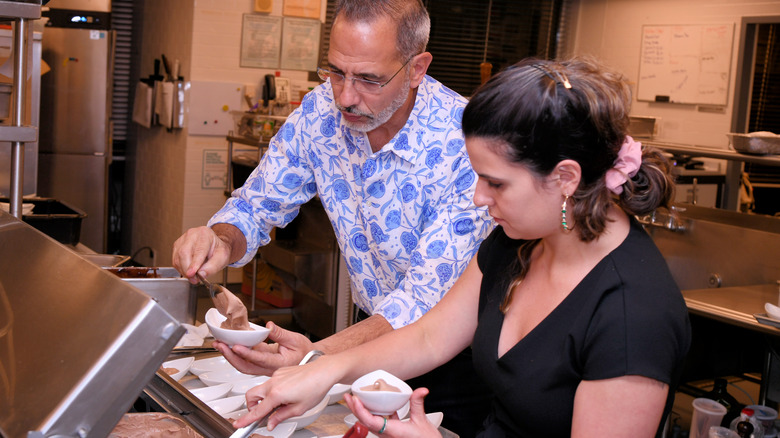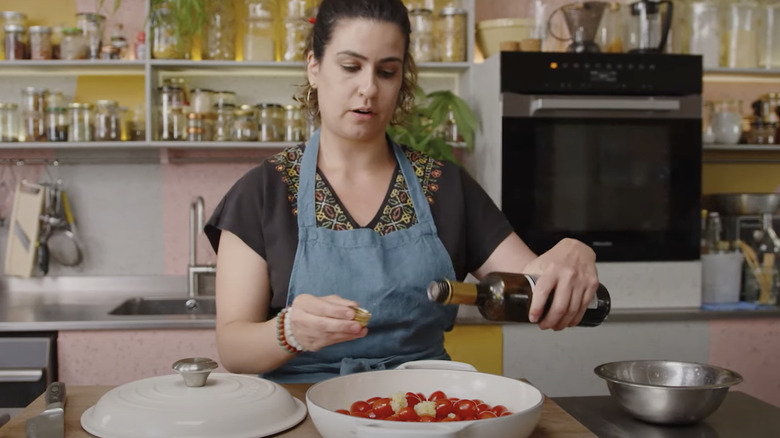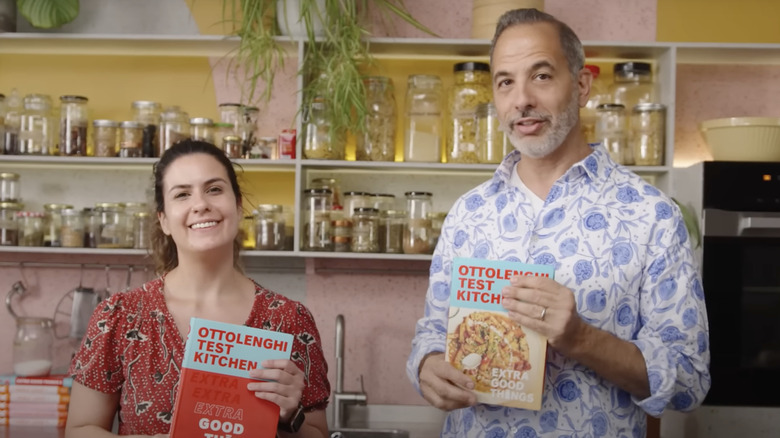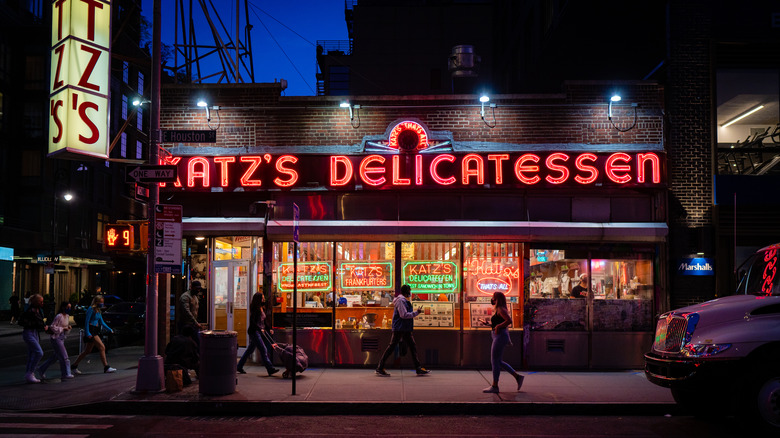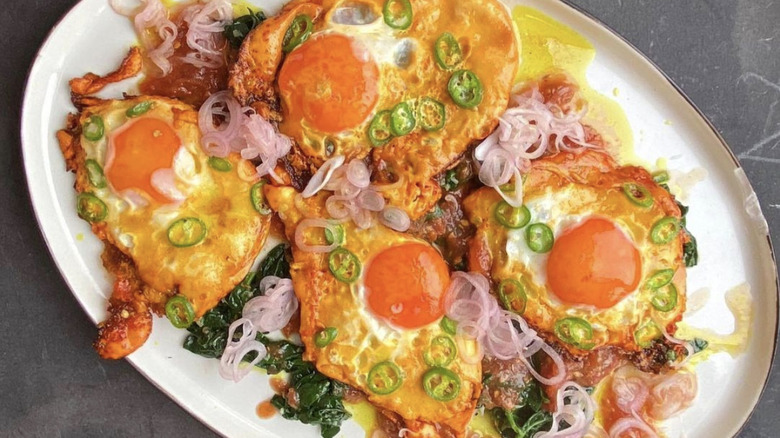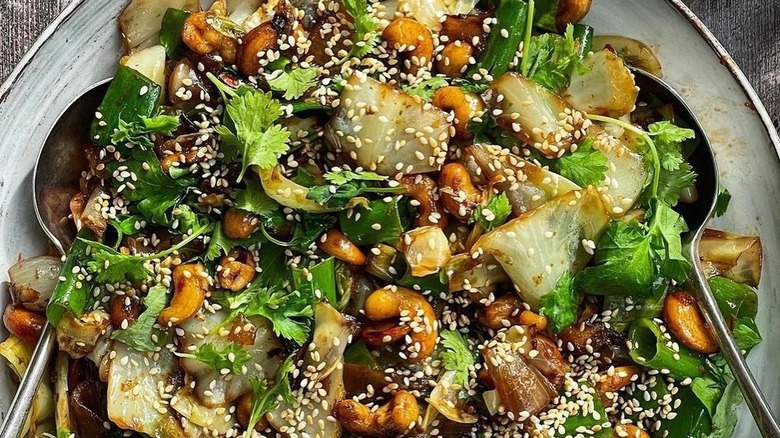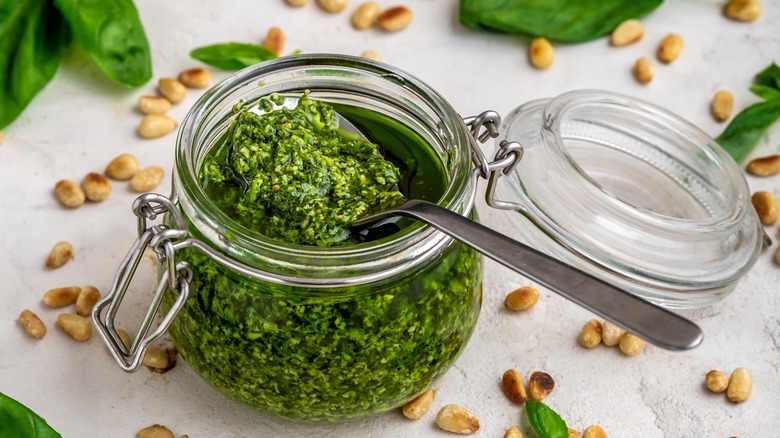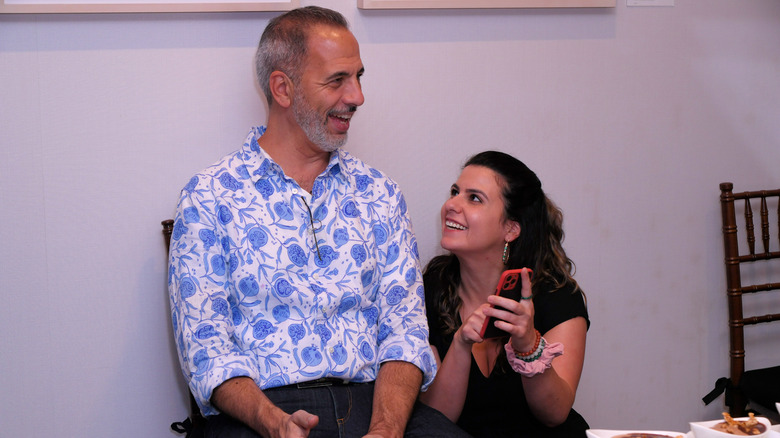Yotam Ottolenghi And Noor Murad On Their New Book And Easy Tricks For Great Flavor - Exclusive Interview
Imagine a space that's one part science laboratory, one part the restaurant of your dreams, and one part Willy Wonka-style factory of wonders. That's a pretty accurate description of the Ottolenghi Test Kitchen. The test kitchen is the brainchild of Israeli-British chef extraordinaire Yotam Ottolenghi, whose cooking blends the flavors of the Middle East and the Mediterranean to create incredibly flavorful dishes where vegetables are the star of the show (via The New Yorker). In addition to the test kitchen, Ottolenghi's empire encompasses delis, restaurants, and nine best-selling cookbooks.
Ottolenghi is a big fan of collaboration in the kitchen, and his last two cookbooks were written in partnership with Ottolenghi Test Kitchen head cook Noor Murad. She brings a wealth of culinary knowledge inspired in part by her childhood growing up in Bahrain. The two chefs' newest collaboration, "Ottolenghi Test Kitchen: Extra Good Things" is a book filled with clever recipes for condiments, pickles, and other small additions that can turn any easy weeknight dinner into a showstopper. In our interview, Murad and Ottolenghi talked about the new book and some of their favorite tips and tricks in the kitchen.
How Extra Good Things was created
What inspired the concept of "Extra Good Things?"
Noor Murad: "Extra Good Things" came after our last book, "Shelf Love." Both ideas were born in the last couple of years when there was a big shift in the way we cooked and ate. "Shelf Love" was all about using up humble ingredients and clearing out your shelves and finding accessible ways to make really good food. "Extra Good Things," on the other hand, is about filling your shelves back up with all the added extras, all the condiments that make a good meal even better.
It also is the way that we were eating at the time, where instead of having to constantly cook meals from scratch — from start to finish — we would go into our fridges or our cupboards where we had all these extras, these condiments, pickles, pestos, chili sauces. We're using them to make very simple meals like a baked potato or cheese on toast, but jazzing them up with all these added extras. That's how the concept came to life and how we brought it into the book.
When you are working on a collaborative book like this one, what's the process like?
Yotam Ottolenghi: It's the same system we've got throughout our recipe development in the Ottolenghi Test Kitchen where different people try different recipes. Then, we all get together and talk about them, have discussions in which we change the recipe, think about how we can improve it, how we can add a little touch or a twist to make it more interesting — more "Ottolenghi," if you like.
The same applies for books. Most of my books over the years have been collaborations in which there are these kinds of conversations going on about the whole concept around the recipes and about the whole book itself. Noor and I had this conversation about the notion of wanting to give people condiments, like she explained, to allow them to create these shortcuts for flavor through those condiments. The condiments allow them to cook more often but with less effort.
With the actual creation of the recipes, Noor led that and used her recipes and recipes from other members of the team to create the chapters, with each chapter doing something slightly different. There are chapters about oils, and there are chapters of sauces and sprinkles and fresh additions. We would taste them, discuss, and see if there's room for improvement. Essentially, Noor led it, and I was part of the conversation throughout to make sure that we would have something that would appeal to as many people as possible.
Go-to homemade condiments
Were there any dishes that you guys had disagreements about?
Murad: I don't actually think so. It's because we have a lot of conversations in the Test Kitchen about food. There's no real ego in the Test Kitchen because you learn that you're going to put up a plate of food and people are going to openly talk about it and discuss it and get it to the best place it could be. We are a small team, and although we all have our own influences and our own tastes and our own cultures, we all want the same thing and know what we're looking for in the end result. I don't think we have many disagreements, and if we do, we always reach a common ground.
What are some good make-ahead condiments or pickles that you return to again and again for quick meals at home?
Ottolenghi: We can highlight some from the book that are really cool and different and special. We have za'atar tomatoes, which are cherry tomatoes that are confited in olive oil with some balsamic vinegar. Once they've gone through this process, they have za'atar added to them and some fresh herbs. That becomes something that can sit in a jar and jazz up meals.
We use it in this book to add freshness to baked polenta with bechamel sauce and feta, but you could use those tomatoes for a whole lot of things. You can eat them almost as they are, but you can serve them on the side with a roast chicken, for example, or a roasted potato with tahini sauce. Almost anything that you would eat, you could eat with those tomatoes.
Noor, do you want to add any other condiments?
Murad: One that I know that Yotam has in his fridge is a quick chili sauce. It's based on a Palestinian shatta. Traditionally, the chilies are salted and left to ferment and then blitzed up. They're kind of tangy and not as spicy, but our version uses shortcuts. We blitz these chilies with vinegar and salt, and we top it up with olive oil. You still have the same result where it's tangy and sour and spicy, and it's a good thing to have in your fridge.
It keeps for quite some time as well. You can spoon it over literally anything. It's a great one to have for families because if someone doesn't like spice, it's on the side, and you can put it onto just your plate if you want it.
Tips and tricks for using spices
Are there any underrated spices that people should use more?
Murad: Fenugreek is an underrated spice.
Ottolenghi: That's right; I agree.
Murad: A lot of people don't know what to do with it because it's very hard. You can't just crush it like you could a cumin seed or a coriander seed. But fenugreek has this amazing flavor. It's very fragrant and it's a bit bitter, but it gives this amazing flavor to the base of stews and curries. We use it in a pickle, and we also use it in these lamb and potato patties.
It's one of those things that if you don't really know how to use it, you might be a bit like, "Oh, I don't know what to do." You stay away from it. In the book, we use it a couple of times because we want people to get over that aversion and use it and cook with it. It needs a bit of a balancing act with a bit of sweetness from sugar and a bit of acidity from something like vinegar or lemon juice. Fenugreek is very underrated.
Since it's so hard, do you infuse it in oil and strain it out or put it through a spice grinder?
Murad: A spice grinder is the best way with fenugreek seeds. You could also go at it with a pestle and mortar and a lot of muscle. You want to get it nice and fine, because otherwise, it can be quite gritty. A spice grinder is the way.
Are there any common mistakes that you see people make when they're using spices in their home cooking?
Ottolenghi: You need to be able to get the right amount in there. You can put something in, but you can't take a spice out. We know that, for instance, turmeric is a great spice, but you need to use it in small measures because it's quite dominant and it also has a certain bitterness to it. It has this glorious color and it adds a bit of warmth and acidity, but only in the right quantity.
My general advice is to start with smaller quantities and add as you go along because it's safer. Get to know your spices and how they interact with each other. Once you've used the spice a few times, then you know roughly how much you want to put in.
Choices for homemade snacks and warming winter food
What are some of your favorite homemade snacks?
Ottolenghi: I've got young kids, and it's always useful to make snacks. I make homemade croutons often, and they come in handy with whatever I give them. When I've got a bit of sourdough left, I never throw the bread away. I use fresh bread or old bread for croutons; it doesn't matter. But I make traditional croutons.
I dice the bread or make little soldiers, like long pieces, and I toss them with some oil, some onion or garlic powder, and maybe some sesame seeds or cumin, and I toast it. Sometimes, I put some other seeds — like pumpkin seeds — with them and it sits in a jar. They love it on soups or stews; it adds that crunch. I keep it for a few days, and it's something that I'm also happy to have occasionally.
Murad: I like cold dates, so I put my dates in the freezer. Once you take them out, they're really, really cold, and you drizzle on a bit of tahini. That's a delicious snack.
It's getting chillier outside, at least for a lot of our readers. What's your favorite winter warmer food?
Murad: Today, we went to Katz's Deli, and we had matzo ball soup. It definitely felt like the best choice for a chilly day like today.
Katz's has enormous matzo balls too, right?
Ottolenghi: It's more matzo balls than soup, that's for sure. When I was growing up, we only had matzo balls at Passover. You'd ask everyone, "You want two or three?" Nobody wanted one, but they were a quarter of the size of these matzo balls. Essentially, you would've had to have four of what we had when I was growing up to equal one of Katz's.
I want to talk about what I love doing. It's not especially wintery, but it's quick and it's warming. There is a recipe in the book for pasta with beans and rocket pesto, and I often do that for the kids. If I want to do a quick meal, I do pasta with either chickpeas or cooked beans that I have, like butter beans or cannellini beans or any beans from a can.
It's such a wonderful thing to do. It's quick, it's easy, and it's warming. In this recipe, we make a pesto from rocket and pine nuts, then grate cheese on top, haloumi. When I make it at home, I make it with whatever herbs I have. It could also be a tomato base or tomato and pepper base, but the kids love it because it's got great texture, and the pasta and the beans always go really well together. This is also a wonderful wintery idea to keep in mind.
A cool technique for flavoring fried eggs
We mentioned turmeric before, but the turmeric fried egg recipe in the book uses a very interesting technique: blooming the turmeric in the oil that you fry the eggs in. How did that recipe come to be?
Murad: In Bahrain, we put a lot of spices into our eggs. When I was little, I would often have fried eggs with turmeric in the oil to give it those beautiful golden edges. We'd also add spice because we love chilies. That came about as a base for the turmeric fried eggs.
The dish evolved because it needed some acidity from the pickled shallots and the tamarind dressing; it needed some green from the spinach. It went on a bit of a journey, but all the flavors came together. More than anything, it's a meal that is very impressive for brunch or if you're cooking for friends. But it's so quick and easy to make, and that's the story of the turmeric fried eggs.
Could you do that technique with other spices too?
Murad: You absolutely could. You could always use some paprika or something if you wanted to. The main thing with these spices, especially any powdered spices, is you want to wake them up by heating them in oil — not heating them so much that they burn, but heating them enough to impart flavor to whatever you're cooking.
Ottolenghi: You can do it also with mild chilies. If you wanted to go a bit more red, mild chilies and some paprika would get you a slightly different version of the theme, and they would look more red than yellow. This is a recipe that I learned to love. It looks so simple, but the turmeric eggs are such a wonderful thing with the spinach and the tamarind. It's sharp and creamy from the yolk. I love those eggs.
Why vegetables should be the heart of any meal
You choose to prepare vegetable-forward dishes, although you're not vegetarian. Why is it so important to celebrate vegetables?
Ottolenghi: They're better than everything else. Often people say, "Why would we eat vegetables?" and I say, "There's a whole lot of reasons to eat more vegetables." [There are] so many reasons, from how good they are to how good it is to eat vegetables as opposed to meat or fish for the environment, health reasons, et cetera.
The number one selling point for me is how tasty they are. Vegetables are these incredible things that you can manipulate and play with and transform through cooking, way more than anything else. The versatility is incredible. With meat, you can do a certain number of things, which are great, but with vegetables, you can do so much more. For me, that is the most important reason.
Murad: I agree. They're also, besides being delicious and versatile, way more budget-friendly than meat.
In America, a lot of cooks are stuck on meat-centric meal ideas. Do you have any advice for people who are trying to increase the amount of vegetables in the food they cook?
Murad: It's finding the vegetables that you love. Start there and find veggies that you actually enjoy eating, because there's no point forcing yourself to eat something you don't like. If you don't like cauliflower, then don't force yourself to eat it. Find the vegetables that you love eating and start trying to eat more of them. It's weird how your palate does change. Once you do start switching and eating a bit more veg, you start craving it, because your body is also loving it too. Slowly, you can explore more things and find what you love.
Ottolenghi: [For] people who like meat, rather than saying, "Don't eat meat," it's fine not to give it up cold turkey or say, "I'm going fully-fledged vegetarian." Have a robust, flavorsome vegetable on the side that could take center stage. Something like the black beans and rice with the jammy peppers that we have could be good. People who like protein would want a protein with it, possibly, but it's got so much going on flavor-wise. The jammy peppers are this wonderful condiment that is sweet and a bit sharp. It's got that depth with peppers and garlic and onions, and the beans with the brown rice are so wholesome. With all that together, you don't crave anything else.
How to use up leftover herbs
Do you have any favorite ways to use the little vegetable odds and ends that collect in your refrigerator beyond vegetable stock?
Murad: If you're cooking an Ottolenghi recipe, there's a good chance there's a lot of herbs in it. Sometimes, you're left with quite a few herbs in the fridge, and we always say don't throw those away. You can use the leaves to make a pesto with whatever nuts you have. You can add cheese or not add cheese, add some lemon zest, garlic, and olive oil, and that will last in your fridge for up to five days. You could also take any of your herb stems and add a bit of vinegar and pickle them and use the pickled herb stems to top any dish that needs some acidity.
Are there any plans for Ottolenghi restaurants or delis to come over to the U.S.?
Ottolenghi: Not at this point, but you'll be the first to know if it changes.
How regional flavors inspire the Ottolenghi Test Kitchen
Noor, your cooking is inspired by the flavors of Bahrain. For people who might not be familiar with that, what makes those flavors special to you?
Murad: Bahrain has quite a unique flavor profile in its food. The Middle East is a very vast place — you have the Levant, you have North Africa, you have the Gulf, you have Iran. My neck of the woods, which is the Gulf countries, draws on lots of different flavor profiles. In Bahrain in particular, we use a lot of Persian flavors — a lot of herbs and sour flavors and dried limes from Iran. But we also have a lot of heavily spiced dishes, a lot of Indian spices, a lot of chutneys and spicy sauces on the side, and then a lot of very grand rice dishes. It's an island, so there's a lot of seafood. You have Persian, Arabic, and Indian flavors all looped into one. That makes it a very unique little island.
The Ottolenghi Test Kitchen recipes also pull from influences from all over. It might be described as Middle Eastern or Mediterranean if you were trying to put a label on it. How do you strike a balance between giving credit to the specific cultures you're drawing from and balancing that with creating things that are more original?
Ottolenghi: Both Noor and I love to mix and match things and borrow from different sources. We get excited about food wherever we find it, ingredients and techniques. The one thing that we have tried to constantly do is tell the stories of the dishes — where they came from, how they came about, and their origins. In my mind, as long as you're very honest about where the source of things comes from, what's their story, and how you got inspired, then you're in safe territory.
We don't want to stop being able to mix up things and play with them because that's the source of all good dishes. Historically, good cuisine has always been these kinds of fusions. When different cultures meet, delicious things come out of it.
"Ottolenghi Test Kitchen: Extra Good Things" is in bookstores now. You can buy it on Amazon.
This interview was edited for clarity.

